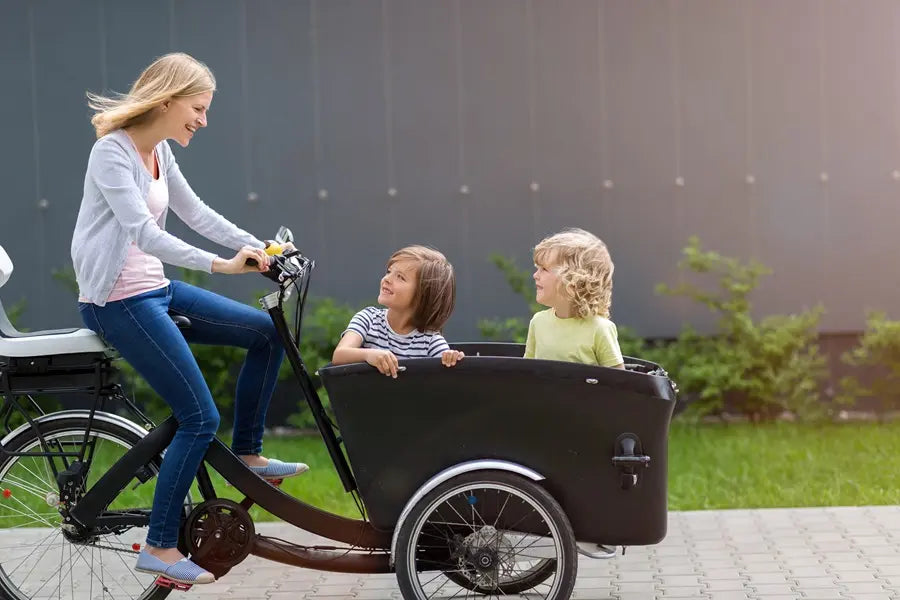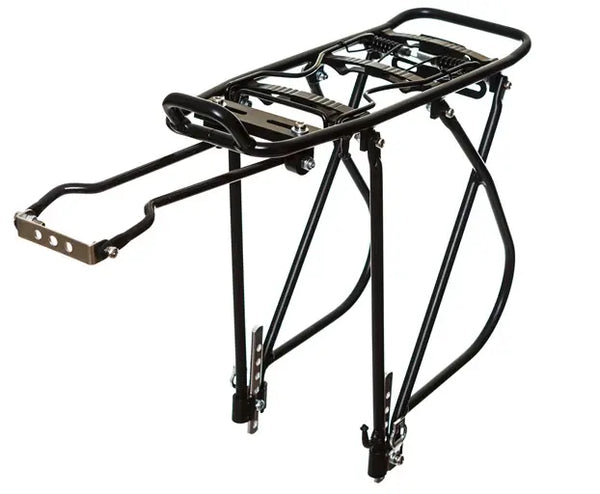Electric bikes, or e-bikes, have become a popular choice for commuting, recreation, and even replacing cars for short trips. But what if you need to carry more than just yourself? E-bikes, particularly cargo e-bikes, are a fantastic solution for hauling groceries, transporting kids, or even running errands around town.
However, electric bikes have weight limits. Understanding these limits and how they apply to different types of e-bikes is crucial for safe and enjoyable riding. eBikeling is here to answer your questions and give you the information to ride confidently and safely.
E-Bike Cargo and Passenger Weight Limits

E-bike weight limits are typically categorized as a total maximum weight limit, or total payload capacity, which includes:
- Rider weight
- Passenger weight (if applicable)
- Cargo weight
- Weight of accessories (e.g., panniers, baskets, child seats)
It's important to note that exceeding the weight limit can:
- Strain the motor and battery, reducing the lifespan of the electric bike
- Affect handling and braking performance
- Increase the risk of accidents
- Void your warranty
Let's delve into the different types of e-bikes and their typical weight capacities.
Standard E-Bikes
These are your everyday e-bikes, designed for commuting and recreation. They typically have a total maximum weight limit of around 250-300 pounds. This weight includes the rider, any cargo on a rear rack (most standard racks are rated for 25-30 lbs), and any accessories.
Pros
- Affordable
- Lightweight
- Readily available
Cons
- Lower weight capacity
- Not ideal for heavy cargo or multiple passengers
E-Bikes with Integrated Rear Racks

Some standard e-bikes come with a stronger, integrated rear rack. These racks can handle more weight, sometimes up to 50-75 pounds. This allows you to carry groceries, backpacks, or even small children on a designated child seat. These e-bikes can carry from 250 lbs to over 400 lbs.
Pros
- More versatile than a standard rack
- Good for carrying moderate loads
Cons
- The weight limit may still not be enough for heavy cargo
- Some models might lack a dedicated child seat option
The Rydy Model I: Your Versatile E-Bike Solution
The Rydy Model I is a feature-packed foldable fat-tire electric bike that is suitable for everyone including heavy riders or those carrying additional loads.
Here's what makes it stand out:
- 750w hub motor: Conquer hills and haul loads with ease. The Rydy Model I's motor provides ample torque for riders and cargo, so it’s ideal for both recreational adventures and utilitarian commutes.
- Fat tires: These wide, knobby tires offer superior traction and stability on various terrains, whether you're cruising paved roads, navigating dirt paths or off-road trails, or tackling snowy conditions. If you want to learn more, don't hesitate to learn more about the advantages of fat tire bikes.
- Cargo-carrying options: The Rydy Model I comes equipped with a rear rack, providing a platform for attaching cargo carriers like pannier bags, a front basket, or a rear basket. It allows you to carry your essentials for errands, groceries, or recreational rides.
- Built to last: The electric bike is constructed with a durable aluminum frame to make sure it can withstand the demands of regular use.
- Effortless riding: Say goodbye to sweat-inducing climbs. Electric assistance takes the strain out of pedaling, especially on hills.
Whether you're a busy parent, an avid adventurer, or a small business owner seeking an efficient and eco-friendly way to make deliveries, the Rydy Model I is the perfect solution. Its impressive weight capacity, powerful motor, and versatile design allow you to perform your daily tasks and explore new possibilities with confidence.
Electric Cargo Bikes

These are the workhorses of the e-bike world, built specifically for hauling heavy cargo. They boast robust frames, powerful motors, and ample cargo space. Cargo e-bikes can have a total maximum weight limit of around 300-550 pounds.
Pros
- Extremely high weight capacity
- Perfect for transporting heavy loads, groceries, multiple children, or pets
Cons
- Heavier and more expensive than standard e-bikes
- May require more maintenance due to carrying heavier loads
Here's a table summarizing the weight limits for different e-bike types:
| E-Bike Type | Typical Total Maximum Weight Limit | Pros | Cons |
|---|---|---|---|
| Standard E-Bike | 250-300 lbs | Affordable, lightweight | Lower weight capacity |
| E-Bike with Integrated Rear Rack | 250-400 lbs | More versatile | Might lack a dedicated child seat option |
| Cargo E-bike | 300-550 lbs | Extremely high weight capacity | Heavier, more expensive |
Things to Consider When Choosing an E-Bike Weight Capacity
What Will You Be Using the E-Bike For?
Occasional groceries or daily commutes with a backpack require a lower weight limit than hauling multiple children or running errands.
Who Will Be Riding with You?
If you plan to carry passengers, factor in their weight and choose an e-bike with a suitable weight limit and designated passenger seating.
Terrain
Riding on flat surfaces allows for a higher weight capacity compared to tackling hills or dirt roads. Steeper inclines require more power from the motor, which exceeding the weight limit can impact.
Safety Tips for Carrying Cargo and Passengers on Your E-Bike

- Always consult your e-bike's owner's manual for the specific weight limit.
- Don't overload your e-bike. Exceeding the weight limit can compromise handling and braking.
- Distribute weight evenly. A lopsided load can make steering difficult.
- Secure your cargo properly. Use bungee cords, straps, or pannier bags to ensure your cargo doesn't shift while riding.
- Start slow and adjust your riding style. A heavier load will affect handling and braking. Increase stopping distances and avoid sharp turns at high speeds.
- Be mindful of your center of gravity. A higher center of gravity can make the e-bike less stable, especially when cornering.
- Inflate your tires to the recommended pressure. This is crucial for optimal handling and performance, especially when carrying a load.
- Maintain your electric bike regularly. Regular maintenance ensures all components are functioning properly to handle the additional stress of carrying cargo.
- Use proper lighting and reflective gear, especially at night, when carrying cargo that might block your taillight.
Expanding Your Cargo-Carrying Options with E-Bikes
Equipping your e-bike with the right accessories opens a world of possibilities for carrying cargo. Here's a breakdown of some popular options.
Rear Racks

Most standard e-bikes come with a rear rack, but some cargo e-bikes have heavy-duty racks specifically designed for significant loads.
Rear racks typically attach to the seat post or frame of the e-bike and provide a platform for attaching baskets, pannier bags, or cargo boxes.
Weight capacity: Standard e-bike racks typically have a weight capacity of 25-35 lbs, while heavy-duty cargo e-bike racks can handle weights exceeding 100 lbs.
Pannier Bags
Pannier bags are like backpacks for your e-bike, attaching to either side of a rear rack. They come in various sizes and materials, offering waterproof options for protecting your belongings from the elements. Pannier bags are a versatile solution for carrying groceries, sporting equipment, work supplies, or school books.
Weight capacity: Pannier bags typically range from 25-50 lbs per bag. Some heavier-duty pannier bags can go up to 70 lbs per bag.
Baskets

Baskets mounted on a front rack or handlebar provide easy access to the smaller cargo you might need during your ride. They’re perfect for carrying lighter items like purses, grocery bags, or picnic supplies. Choose a basket with a sturdy construction and secure mounting system to prevent items from bouncing out while riding.
Weight capacity: E-bike baskets range from 10-20 lbs.
Cargo Boxes
Cargo boxes offer a secure and weatherproof storage solution for your belongings. They typically mount on a rear rack and come in various sizes, providing ample space for groceries, tools, sporting equipment, or even a pet (depending on the size and local regulations). Some cargo boxes even come equipped with features like locks, lights, and reflective materials for added security and visibility.
Weight capacity: They range from 50-100 lbs for some models and exceed 100 lbs for heavy-duty cargo boxes.
Trailers

For ultimate cargo capacity, consider using a trailer specifically designed for e-bikes. E-bike trailers come in various configurations, from enclosed cargo trailers to passenger trailers that can comfortably seat one or two children.
Weight capacity:
- Low-capacity trailers: These are suitable for light to moderate cargo needs, with a carrying capacity ranging from 100 to 200 lbs. They could be ideal for groceries, sporting equipment, or pets.
- High-capacity trailers: Designed for heavier loads, these trailers can handle weights exceeding 200 lbs, sometimes reaching up to 400 lbs. They’re suitable for hauling large items or multiple passengers (depending on the trailer configuration and local regulations).
Child Seats
E-bikes can be specifically designed to accommodate child seats, transforming them into a fun and eco-friendly mode of transportation for families. Make sure the child seat is properly mounted and secured to your e-bike frame, and never carry more than one child in a designated seat.
Weight capacity: Most e-bike child seats adhere to the European safety standard EN 14344 and are designed for children who can sit upright independently, with a weight from 20 lbs up to 48.5 lbs (from around 9 months to 5 years old).
By following these safety tips and choosing the right cargo-carrying options for your e-bike, you can experience the joy and convenience of hauling your precious cargo with ease. Of course, if you have any questions, our team at eBikeling is only a phone call away.
Conclusion
When you know what you’re looking for, e-bike weight limits, and safety tips, you’re all set up to have an excellent experience riding your e-bike with cargo or passengers.
If you need assistance or guidance, contact eBikeling today to choose your perfect electric bike or explore our e-bike conversion kits for all bikes and budgets, e-bike components, batteries, and accessories.





